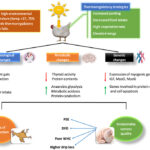Scientific communication is a vital skill for every researcher. Whether through research papers or oral presentations, the ability to clearly and effectively convey your findings determines how well your work is understood, appreciated, and applied by others.
1. Paper Writing
Writing a research paper involves systematically presenting the results of your research in a structured and scholarly format. It serves as a formal channel to share new knowledge, methodologies, and innovations.
Key Components of a Research Paper:
- Title: Concise, descriptive, and reflective of the content.
- Abstract: A brief summary of the objective, methods, results, and conclusion.
- Keywords: Relevant terms to help with indexing and searchability.
- Introduction:
- Background and context.
- Literature review and research gap.
- Statement of the problem and objectives.
- Materials and Methods:
- Detailed procedures and tools.
- Sample size and statistical techniques.
- Results:
- Presentation of findings using tables, charts, and graphs.
- Discussion:
- Interpretation of results.
- Comparison with previous studies.
- Implications and limitations.
- Conclusion:
- Summary of key findings.
- Future recommendations.
- References:
- Cited using appropriate academic style (APA, MLA, Harvard, etc.).
Tips for Writing:
- Use clear and precise language.
- Maintain logical flow and coherence.
- Avoid unnecessary jargon.
- Support arguments with evidence and citations.
- Revise and proofread for grammar, clarity, and formatting.
2. Oral Presentations
Oral presentations are a common method of communicating research findings at conferences, seminars, and workshops. A good presentation combines content, clarity, and confidence.
Structure of an Oral Presentation:
- Title Slide: Includes your name, affiliation, and the topic.
- Introduction:
- Brief background and research problem.
- Objectives of the study.
- Methodology:
- Study design, sampling, tools used.
- Results:
- Use of visuals (charts, tables, figures) for clarity.
- Discussion and Conclusion:
- Interpret findings and state key conclusions.
- Acknowledgments and Q&A Session
3. Tips for Effective Oral Presentations
✅ Before the Presentation:
- Know your audience: Tailor your language and depth of content.
- Prepare your slides:
- Use simple and clean designs.
- Limit text – aim for bullet points, visuals, and concise labels.
- Use readable fonts and contrasting colors.
- Rehearse multiple times to ensure fluency and timing.
✅ During the Presentation:
- Start strong: Introduce yourself and your topic clearly and confidently.
- Speak clearly and at a moderate pace.
- Make eye contact with the audience, not just the screen.
- Use visuals to support your speech, not to replace it.
- Stick to the time limit: Practice beforehand to manage timing.
- Engage the audience: Ask questions or invite brief interactions if appropriate.
- Handle questions politely and professionally, even if you don’t know the answer.
✅ Common Mistakes to Avoid:
- Reading slides word-for-word.
- Using too much technical jargon.
- Overloading slides with data or text.
- Speaking too fast or too softly.
- Ignoring the time limit.
Conclusion
Effective paper writing and oral presentation skills are essential tools for researchers to disseminate their findings. A well-written paper ensures academic recognition, while a strong oral presentation can engage audiences, open opportunities for collaboration, and promote knowledge exchange. Mastery in both forms of communication enhances the overall impact of scientific research.




Great informative
Nice.. knowledge full
To the point